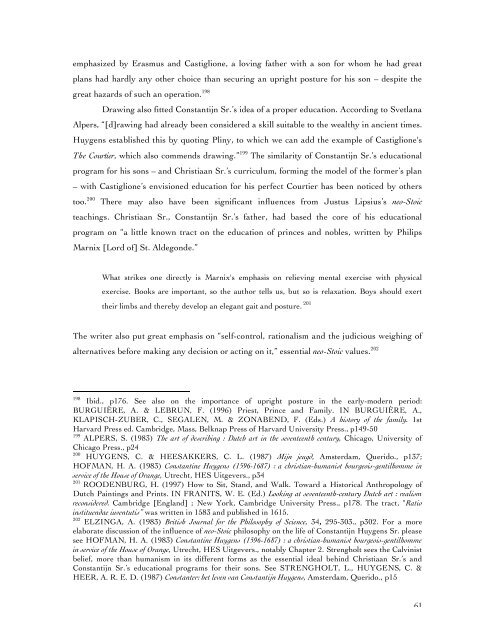Christiaan Huygens – A family affair - Proeven van Vroeger
Christiaan Huygens – A family affair - Proeven van Vroeger
Christiaan Huygens – A family affair - Proeven van Vroeger
Create successful ePaper yourself
Turn your PDF publications into a flip-book with our unique Google optimized e-Paper software.
emphasized by Erasmus and Castiglione, a loving father with a son for whom he had great<br />
plans had hardly any other choice than securing an upright posture for his son <strong>–</strong> despite the<br />
great hazards of such an operation. 198<br />
Drawing also fitted Constantijn Sr.’s idea of a proper education. According to Svetlana<br />
Alpers, “[d]rawing had already been considered a skill suitable to the wealthy in ancient times.<br />
<strong>Huygens</strong> established this by quoting Pliny, to which we can add the example of Castiglione's<br />
The Courtier, which also commends drawing.” 199 The similarity of Constantijn Sr.’s educational<br />
program for his sons <strong>–</strong> and <strong>Christiaan</strong> Sr.’s curriculum, forming the model of the former’s plan<br />
<strong>–</strong> with Castiglione’s envisioned education for his perfect Courtier has been noticed by others<br />
too. 200 There may also have been significant influences from Justus Lipsius’s neo-Stoic<br />
teachings. <strong>Christiaan</strong> Sr., Constantijn Sr.’s father, had based the core of his educational<br />
program on “a little known tract on the education of princes and nobles, written by Philips<br />
Marnix [Lord of] St. Aldegonde.”<br />
What strikes one directly is Marnix's emphasis on relieving mental exercise with physical<br />
exercise. Books are important, so the author tells us, but so is relaxation. Boys should exert<br />
their limbs and thereby develop an elegant gait and posture. 201<br />
The writer also put great emphasis on “self-control, rationalism and the judicious weighing of<br />
alternatives before making any decision or acting on it,” essential neo-Stoic values. 202<br />
198<br />
Ibid., p176. See also on the importance of upright posture in the early-modern period:<br />
BURGUIÈRE, A. & LEBRUN, F. (1996) Priest, Prince and Family. IN BURGUIÈRE, A.,<br />
KLAPISCH-ZUBER, C., SEGALEN, M. & ZONABEND, F. (Eds.) A history of the <strong>family</strong>. 1st<br />
Harvard Press ed. Cambridge, Mass, Belknap Press of Harvard University Press., p149-50<br />
199<br />
ALPERS, S. (1983) The art of describing : Dutch art in the seventeenth century, Chicago, University of<br />
Chicago Press., p24<br />
200<br />
HUYGENS, C. & HEESAKKERS, C. L. (1987) Mijn jeugd, Amsterdam, Querido., p137;<br />
HOFMAN, H. A. (1983) Constantine <strong>Huygens</strong> (1596-1687) : a christian-humanist bourgeois-gentilhomme in<br />
service of the House of Orange, Utrecht, HES Uitgevers., p34<br />
201<br />
ROODENBURG, H. (1997) How to Sit, Stand, and Walk. Toward a Historical Anthropology of<br />
Dutch Paintings and Prints. IN FRANITS, W. E. (Ed.) Looking at seventeenth-century Dutch art : realism<br />
reconsidered. Cambridge [England] ; New York, Cambridge University Press., p178. The tract, “Ratio<br />
instituendae iuventutis” was written in 1583 and published in 1615.<br />
202<br />
ELZINGA, A. (1983) British Journal for the Philosophy of Science, 34, 295-303., p302. For a more<br />
elaborate discussion of the influence of neo-Stoic philosophy on the life of Constantijn <strong>Huygens</strong> Sr. please<br />
see HOFMAN, H. A. (1983) Constantine <strong>Huygens</strong> (1596-1687) : a christian-humanist bourgeois-gentilhomme<br />
in service of the House of Orange, Utrecht, HES Uitgevers., notably Chapter 2. Strengholt sees the Calvinist<br />
belief, more than humanism in its different forms as the essential ideal behind <strong>Christiaan</strong> Sr.’s and<br />
Constantijn Sr.’s educational programs for their sons. See STRENGHOLT, L., HUYGENS, C. &<br />
HEER, A. R. E. D. (1987) Constanter: het leven <strong>van</strong> Constantijn <strong>Huygens</strong>, Amsterdam, Querido., p15<br />
61


